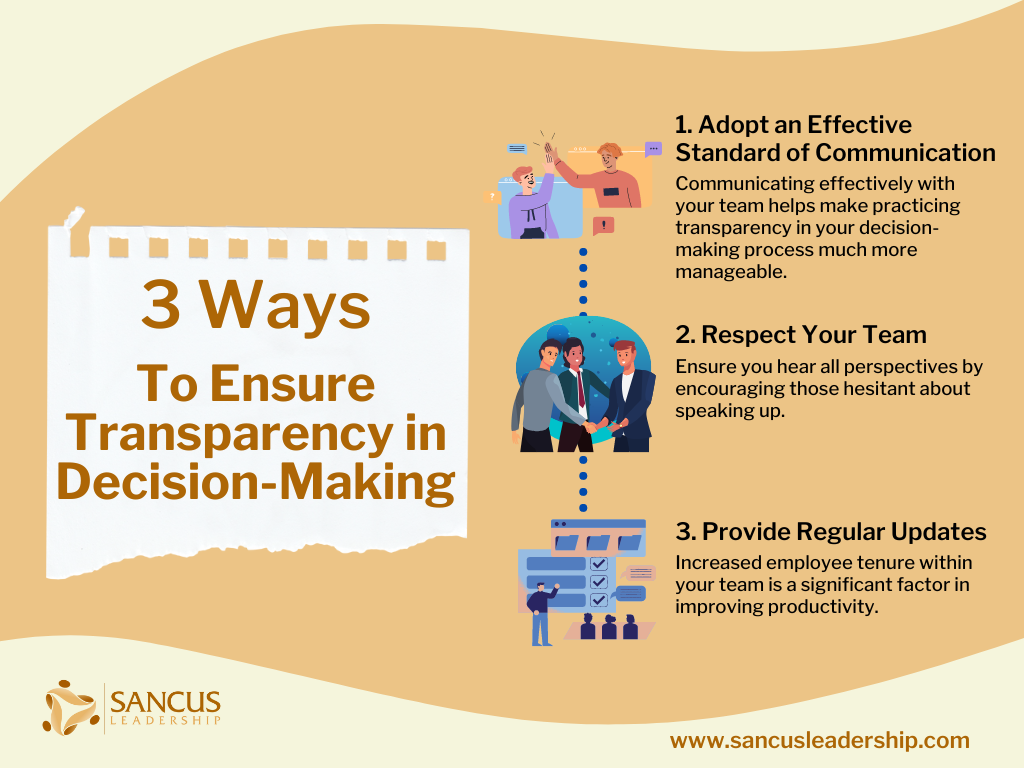Do you shy away from transparent decision-making, thinking it might slow you down or unnecessarily expose your weaknesses? Mind you, this mindset can quickly backfire since it puts you in a position where you may feel you’re almost indefatigable and solely responsible for the team’s progress — a feat not even the best and the brightest leaders in the world can carry through. It places the team’s stability, well-being, and efficiency at risk.
Transparency in decision-making is a great way to ensure that your business interests are always prioritized. Ensure transparency by adopting an open, inclusive culture where everyone’s skills, experiences, and input are always valued. Be a team player, as well as an effective leader.
Read on if you’re interested in promoting transparency in the workplace and see value in establishing it in your decision-making processes. We will talk about the signs you must watch out for that indicate probable flaws in your communication strategies and the consequences the business might suffer if these issues aren’t nipped in the bud. Then, we will discuss simple yet effective ways to ensure transparency in your team.
4 Signs That You Don’t Apply Transparency in Decision-Making

“When did the policy change?” “Why did they change the policy?”
“I had no idea we had to do this!”
Are statements such as these something you frequently overhear in the workplace? Do these take you entirely by surprise because you’ve always believed you practice transparency in your leadership, particularly in your decision-making processes? Some leaders might even feel affronted or shocked by such sentiments because they think they’ve always been open to their team.
Unawareness that you don’t practice transparency in decision-making can have disastrous consequences. This issue must be promptly addressed before it blows up in your face.
Unawareness that you don’t practice transparency in decision-making can have disastrous consequences.
A friend told me a story about Beth, a colleague of hers who led a small team in the pharmaceutical sales industry. Beth prided herself on her capability and initiative to maintain transparency in practically all aspects of her team. She has made it her main thrust in her leadership brand, projecting herself as an approachable, relatable leader.
Beth was jarred into reality one morning when, during a meeting with a prospective client, two of her team members started discussing a discounting scheme she had previously decided to discontinue. She did all she could to salvage the situation, but they confused the client and created doubts in his mind about their sincerity. They eventually lost the sale.
Upon confronting her employees about the supposed error, Beth learned they weren’t aware that the scheme was discontinued. This prompted her to call an emergency meeting with her entire team, and that’s when she uncovered a lot of miscommunications and confusion.
While some team members were aware of the discontinuation, others needed clarification on its effectiveness date. Moreover, several of her employees were required to be more aware of the new policy, thinking it was still in the process of approval.
Beth was utterly shocked by her discovery, especially since she was sure she had always been transparent with her team. It all boiled down to one issue — she failed to see the signs that her tactics were ineffective. Looking back, she realized there were indications of confusion, uncertainty, and frustration within her team — she just failed to acknowledge and act on them.
Here are some signs that Beth may have inadvertently ignored and that you might want to be on the lookout for to help you determine whether you’re effectively applying transparency in your decision-making process as a leader:
Passive-Aggressive Behavior
You might mistake passive-aggressiveness in a team member as a sign that they’re merely disinterested, going through a rough patch, or that it’s simply their personality type. However, this behavior is worth taking a closer look at because it may indicate that your team member is confused, unsure, or dissatisfied about certain aspects of the workplace.
You might find some team members agreeing with you publicly, but later on, you see them doing exactly the opposite of what was agreed upon. Some people resort to this behavior because they might feel frustrated that they don’t have opportunities to speak their minds or are dissatisfied with your leadership.
Ulterior Motives
Teamwork should always be apparent in the workplace. Some employees may need help digesting new information and adapting to new policies. Still, if you notice some of their teammates attempting to take advantage of the situation, that’s a red flag.
Teamwork should always be apparent in the workplace.
Some team members might exploit their colleagues’ lack of comprehension and confusion to gain unfair traction in the organization. When you’re ineffective in dispersing crucial information, some people might take advantage by projecting themselves in a more positive light by bringing their teammates down rather than assisting and collaborating with them.
Instead of helping their teammates better understand various aspects of the team, they would watch them falter and fail so they would appear more proficient than they genuinely are. As a leader, this can get very frustrating because you expect your team members to work synergistically toward common objectives.
Strained Connections
When leading a team, you aim to earn your team members’ trust, respect, and accolades, and one way of doing this is through honesty and transparency.
However, as their leader, you also need to set yourself apart. You must acknowledge and leverage your authority to lead your employees toward common goals while keeping the team united, synergistic, and productive. The famous saying, “We’re all in this together,” must resonate within your team.
If you sense your employees’ “us vs. you” attitude, maybe it’s time to rethink your methodologies, especially concerning transparency. Your attempts at being open and forthright are being taken in a negative light.
Strained connections in the workplace are never healthy. Your team should see you as someone they can trust, respect, and emulate. You must be able to make them feel that they’re in good hands. Your team members should feel they can safely approach you anytime they have concerns about their job, the workplace, or anything regarding the team and the organization.
Misalignment
Your communication skills may seem adequate for some of your team members, but if you notice a handful of them straying away from the set objectives, take it as a sign that your team needs more transparency.
Establishing common goals — and staying committed to them — is crucial to the progress and success of your team. Everyone must be aligned with these goals, and all efforts, decisions, and plans must adhere to their attainment. If some team members exhibit signs of misdirection, it’s highly possible that they’re unclear about the direction the team is going, and you need to address this issue quickly before things go out of control.
3 Effects of a Non-Transparent Decision-Making Process

The lack of transparency, particularly in decision-making, can adversely affect your business. Effectively managing a team means you have to quickly identify these signs so you can make the necessary adjustments in your management style.
Here are some of the adverse effects of a non-transparent decision-making process:
Ineffective Decision-Making
Leading a team requires you to make decisions that are always in the best interest of the organization and your team. If you do not practice transparency, there’s a higher probability that your choices are ill-informed and not aligned with the team’s sentiments.
To address these promptly, you must be in tune with your team’s needs, wants, and expectations. After all, your employees are the main driving forces in the organization and most likely have first-hand knowledge and experience in the nitty-gritty of business operations.
Lack of Accountability
People not fully invested in the business tend to point fingers the minute something goes wrong. With a lack of transparency, it would be more challenging to hold people accountable for their actions and make them feel more responsible for their words. A team that refuses to be held liable for their vital roles in the organization can quickly pull the business down.
If you’re transparent with your team and include them in the decision-making process, you choose with them rather than for them. This changes the game significantly because it allows you to foster accountability in your team members by making them more mindful and intentional with their work.
Poor Employee Retention
Good employee retention is crucial to a business’s development, stability, and success. It helps ensure the organization functions seamlessly and synergistically with as few disruptions as possible.
A high employee turnover rate has numerous adverse effects on a business. Here are some of them:
- Workflow disruption
- Poor employee productivity
- Low morale
- Low levels of trust
- Missed growth opportunities (especially from recurring and new business opportunities handled by a specific employee)
- Unrealized investments (both for potential clients and the time and effort invested in enhancing an employee’s skills and experiences)
- Disrupted customer services (some clients may be loyal to your employees, not to your company)
- Additional recruitment expenses
- Training expenses
- Turnover expenses
- Loss of valuable business information (an employee leaving your team will bring with them all the knowledge and skills they learned, along with the clientele profile they’ve accumulated throughout their career)
| Effects of a Non-Transparent Decision-Making Process | Description |
| Ineffective Decision-Making | Team members might feel excluded or undervalued, eroding trust and collaboration. Ambiguity about the decision-making process can also hinder the understanding of objectives, causing confusion and misalignment. |
| Lack of Accountability | This can lead to a diffusion of responsibility, where no one feels directly answerable for the outcomes. As a consequence, there is a diminished sense of ownership and commitment to the decisions made. |
| Poor Employee Retention | When employees feel excluded from the decision-making process and are unaware of the rationale behind key choices, they may experience frustration, disengagement, and a sense of being undervalued. This can lead to decreased job satisfaction and a higher likelihood of seeking opportunities elsewhere, ultimately contributing to a higher turnover rate. |
3 Ways To Ensure Transparency in Decision-Making

The need for more transparency in decision-making creates problems that can be avoided by merely practicing openness, honesty, discretion, and inclusivity in managing and communicating with your team. Finding the perfect balance is tricky, but by being consistent and deliberate, you’ll soon be reaping the benefits.
Here are some ways you can ensure transparency in your decision-making process:
Adopt an Effective Standard of Communication
A transparent and inclusive standard of communication must be observed within your organization. Ensure that your team members know and understand how they fit into the organization’s thrust and how vital their roles are in attaining growth and success for the team.
Here are some tips:
- Consider your team’s diversity. Tailor-fit your approach based on each individual’s personality type. Your communication style should not have a one-size-fits-all approach.
- Connect powerfully with your team members. Deliver the right messages only to the appropriate people involved. Transparency isn’t about sharing all information with everyone on your team.
- Avoid oversharing. Sharing too much irrelevant information leads to misunderstandings, false assumptions, and confusion.
Communicating effectively with your team helps make practicing transparency in your decision-making process much more manageable. It helps make each team member feel valued, involved, and relevant. This can significantly improve team morale, engagement, and productivity.
Respect Your Team
As the saying goes, “Respect begets respect.” One surefire way for you to earn the respect of your team is by consistently showing them respect yourself. Although you occupy a crucial position in the organization, offer your team members that you recognize and value their unique competencies and experiences.
Encourage transparency by actively listening to your team. When you come to them for insights on solving a particular problem, ensure you are eager to learn and hear their input. Showing up with the solution already established in your mind will be apparent in how you act and speak, and they will quickly catch on. Ensure you hear all perspectives by encouraging those hesitant about speaking up.
Encourage transparency by actively listening to your team.
This way, all voices are heard, enabling you to establish inclusivity in leading and managing your team firmly. You can accomplish this through engaging and collaborative team meetings, one-on-one discussions, surveys, and polls. This is also a great way to encourage employees to be more intentional and embrace accountability for their decisions and actions.
Provide Regular Updates
Remember my friend Beth’s story? One key factor in her failure to ensure transparency in her team is her oversight in providing feedback and updates on the status of the discontinued discounting scheme. If only she had clearly stated that the discontinuation was formally finalized, none of her team members would have assumed that it was still in effect, avoiding that embarrassing fiasco with a potential client.
Provide regular updates to your team — verbally or in written form — to keep them abreast of what’s happening in the organization. This way, you prevent misunderstandings and confusion, especially if you ensure you deliver your messages as concisely as possible.
Happy, engaged, and motivated employees love their jobs more, prompting them to stay longer in the organization. Increased employee tenure within your team is a significant factor in improving productivity.
Increased employee tenure within your team is a significant factor in improving productivity.

How To Implement Transparency in Your Organization

Sancus Leadership has teamed up with Cloverpop.com to help you navigate the most critical decisions you must make as a leader. You can always go right with our expert guidance, owing to our long history of developing speedy, reliable, and transparent decision-making processes for our clients.
Book a leadership session with us to learn how we can help you make better, faster decisions with your team!
Here’s a video discussing the importance of transparency in leadership and tips on how to achieve it.
Key Takeaways
A common cause of dissatisfaction in the workplace is the lack of transparency, particularly in the decision-making process. Employees are frequently subjected to changes in regulations and strategies without even a short consultation on their opinions, sentiments, and suggestions. This results in ineffective solutions to problems, a lack of accountability, and higher employee turnover.
Transparency in decision-making can significantly affect how you can find the best solutions for your company’s most pressing concerns. By focusing on what information to share and who to share it with and considering the perspectives of as many people as possible, you’ll encourage collaboration, commitment, and productivity.



